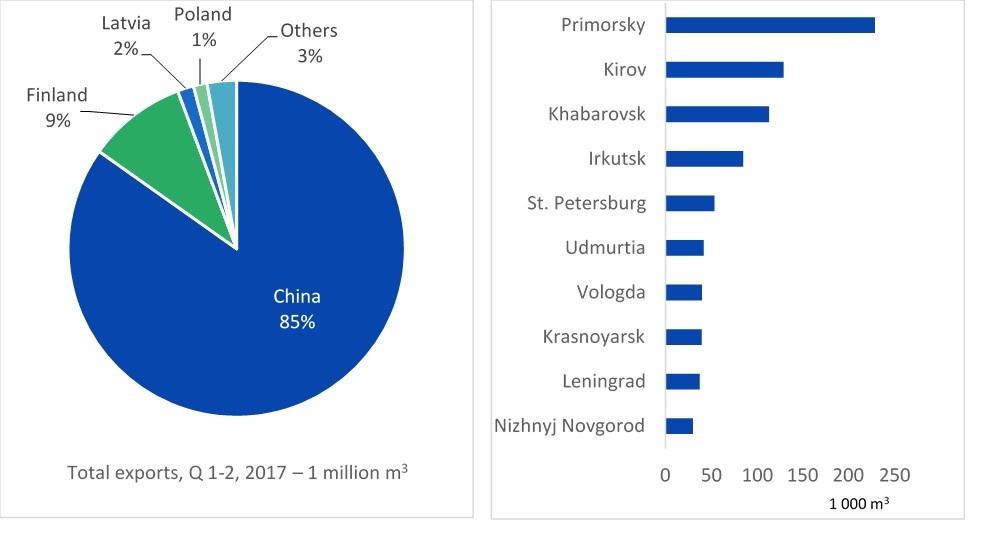2 min read
Scarcity of Birch Veneer Logs in Russia Raises Questions
Vasylysa Hänninen : December 12, 2017

In October, 2017, Forest2Market partners from Indufor, Vasylysa Hänninen and Antti Kämäräinen, participated in a birch plywood roundtable hosted in St. Petersburg, Russia. This event was organized as a part of the 19th annual St. Petersburg International Forestry Forum, and scarcity of birch veneer logs was the hottest topic for discussion. Following is a post about the event from Vasylysa Hänninen.
Russian wood-consuming companies are facing birch supply challenges, regardless of whether they procure fiber from their own forest leases or market suppliers.
In fact, it is estimated that from 2013-2017, birch veneer log prices increased more than 75 percent in local currency (16 percent in Euros). Furthermore, the leading Russian mills have to pay price premiums on top of the general log prices and in order to secure sufficient volumes, some Russian plywood producers are forced to haul logs from over 900 miles away.
During the roundtable, several factors were identified as the primary causes of this situation.
 Panel at the 19th annual St. Petersburg International Forestry Forum in St. Petersburg, Russia
Panel at the 19th annual St. Petersburg International Forestry Forum in St. Petersburg, Russia
Firstly, there is an imbalance in the consumption of various wood raw material products in Russia. For example, while birch plywood mills consume over 9 million cubic meters (m3) of logs annually, birch pulpwood consumption is considerably lower. In fact, only two pulp mills (IP Svetogorsk and Titan’s Arkhangelsk P&P mill) consume birch pulpwood and there are a few particleboard producers that also use this resource. With a high demand for larger-sized timber, logging companies are forced to allocate a significant share of their costs to harvesting birch logs and the supply/demand situation is unlikely to change in the near future. There are no large birch pulpwood-consuming investment projects on the horizon aside from Sveza’s ambitious pulp mill project in the Vologda region, which will not do much to change the disproportionate demand.
Secondly, birch veneer log exports are escalating rapidly; export volumes from Russia are estimated to be 1.5-1.6 million m3 for 2016 vs. 1.3 million m3 in 2015. China is the leading buyer, having consumed 75 percent of the total volume in 2015 and as high as 85 percent in 2016, followed by neighboring Finland. Other export destinations consuming much smaller volumes include Poland, Latvia and Belarus.
Recent analysis of Russian exports in the first half of 2017 demonstrates an increase in birch log exports. By the end of June 2017, slightly over 1 million m3 of birch logs were exported, with China holding an 85 percent share. The largest exporting regions are located in the areas where there is no birch plywood production (Primorksy, Khabarovsky Krai), but there has also been an increase in harvests and export activity in Western Russia, which has a strong domestic birch plywood industry. These exports pose a considerable resource threat for the regional plywood facilities, as demand for quality birch logs (and prices) have increased dramatically.
 Birch veneer log exports from Russia, 1st half 2017
Birch veneer log exports from Russia, 1st half 2017
Thirdly, easily-accessible forest resources are getting harder and harder to find in Russia, leading to drastic cost increases in supply chain management, namely harvesting, transportation and logistics operations. Major infrastructure improvements are not carried out on regular basis and forest resources are located further and further from the existing roads. Recent mild winters have not improved loggability and very little harvesting was completed last summer due to exceptionally high levels of rainfall.
There were differing opinions about the feasibility of a possible export ban of birch veneer logs during the roundtable. As was the case with the heavy duties that were imposed on log exports from Russia in 2008, some fear that an export ban will cause numerous bankruptcies among harvesting companies, which could lead to a shortage of logs and an increase in market price. Also, implementing an export ban on a national scale would needlessly harm harvesting companies in Eastern Siberia and the Russian Far East, where there is no domestic processing industry or in-country competition for birch logs. That said, some Russian plywood producers believe that an export ban of birch veneer logs would benefit their businesses.
In my next blog, I will examine Russia’s birch plywood industry structure as well as market trends driving and affecting the industry.




